from
Behind the French Menu
by
Bryan G. Newman
behindthefrenchmenu@gmail.com
Seaweed
Photograph
courtesy of bookfinch
www.flickr.com/photos/mamsy/22325687481/
Seaweed in France
There are over 100 edible seaweeds, but French chefs rely on products grown close to home and are readily available. Today France grows seaweed commercially, and the export of seaweed is big business. After Japan, China, and Ireland, France is the largest commercial producer of farmed seaweed.
One or more seaweeds may well be flavoring your fish soup or seafood and saltwater fish dishes; seaweed may also be seasoning meats or be part of a mixed seaweed salad or served along with regular salad greens.
France’s use of seaweed in the kitchen has a history as long as that of Japan. French recipes for seaweed are found in late 15th-century cookbooks and more are added today
Seaweed on French menus:
Dos de Skrei au Beurre d'Algues –
A thick cut from the back of rehydrated and desalted cod, served with seaweed butter.
Rehydrated and desalted cod was one of the fish that could keep until needed and
was the only sea fish that was regularly seen inland in France and on long sea
voyages; it has hundreds of recipes and is very popular. The butter will be
a compound butter; that means the butter was
warmed, mixed with seaweed, cooled, and served as a condiment. It will be added
when the dish is served; then it will slowly melt and flavor the fish.
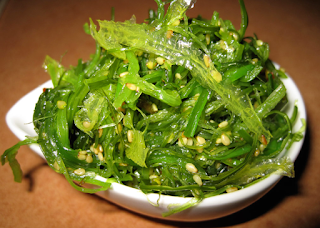
Wakame
Photograph
courtesy of Sante-Globale
Filet de Bœuf Aubrac, Algues, Huitres, Écrasée de Ratte- A cut from the fillet of France's Aubrac cattle served with seaweed, oysters, and crushed/mashed ratte potatoes. (The potato called ratte in French has an odd shape and was considered to look like a small rat. Despite the name, the tasty ratte potato is among the most popular potatoes in France).
The beef fillet comes from the Bœuf Fermier d'Aubrac, Label Rouge, red label rated, farm-raised beef cattle of Aubrac. The L'Aubrac plateau where these cattle graze for seven or eight months of the year reaches from the south of the Massif Central and through parts of three departments, including Lozère and Aveyron in Occitanie, and Cantal in the Auvergne-Rhône-Alpes.

Green asparagus poached in kombu.
Photograph
courtesy of City Foodsters
www.flickr.com/photos/cityfoodsters/18665201943/
Gaufre aux Algues, Caviar d'Aquitaine Impérial Baeri – Waffles or wafers made with seaweed that accompanies caviar Baeri. The “Imperial Baeri” comes from farmed Siberian Sturgeon. Here the caviar comes from the region of Nouvelle Aquitaine, and that indicates one of the sturgeon farms on the Gironde or Garonne rivers near to Bordeaux.
Le Roulé de Saumon à la Ricotta et sa Feuille d'Algue Nori - Salmon prepared with ricotta cheese and then rolled inside leaves of Nori/porphyre seaweed.

Salade d’Haricots de Mer à la Roquette
Photograph
courtesy of Crusine d'Asie
Le Carpaccio d'Espadon et sa Petite Salade de Wakamé – A swordfish carpaccio served with a small wakamé seaweed salad.
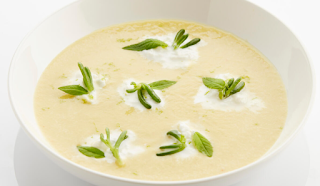
Soupe
Froide de Chou Marin
(with the recipe).
Photograph courtesy of Koppert Cress
Merlan à la Vapeur d’Algue, Légumes Sautés a Cru, Pommes Darphin - Whiting, the fish, steamed over seaweed and served with fresh vegetables very lightly sautéed and pommes darphin. Pommes darphin are grated potatoes cooked in a frying pan with seasoning; when ready, they will look somewhat like a thick pancake.

Spaghettis
aux Fruits de Mer et Haricots de Mer
Photograph courtesy of La Cuisine a Quatre Mains
Tartare de Saumon aux Algues - Fresh salmon prepared as a Tartar and flavored with seaweed.
Farmed Seaweed
Farmed seaweed is part of many of the world's cuisines. Agar-Agar you may never have heard of, but along with similar seaweeds, it is grown for use as a vegetable emulsifier, a thickening agent. Agar-agar and its cousins are crucial for the canned and preserved food industry. You probably eat some agar-agar every day. If you see vegetable gelatin on a list of contents, that is probably agar-agar. Another seaweed called chondrus crispus is used as a thickener and stabilizer in milk products, including ice cream and other processed foods; in Europe, its use will be indicated on the list of contents as E407 or E407b.
Some of the most popular French seaweeds include:
Chou Marin, Chourbe, Crambé Maritime, Chou de Mer or Crambe – Sea kale; despite its name, this particular kale does not grow in the water; it is a member of the cabbage family that likes being near the sea. Sea Kale grows along the shore; in the wild, it is a protected plant. However, it is also cultivated and so occasionally appears on a menu with its young shoots as a separate dish; older leaves may be served as a garnish. Latin - (crambe maritima).
Fougère de Mer, Wakamé - Sea mustard, wakame in Japanese, a member of the kelp family. This seaweed has a combined slightly sweet and strong flavor and is most often seen in miso soup in Japan and salads in French dishes. (Latin - undaria pinnatifida).
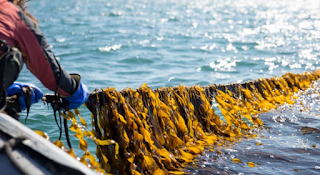
Seaweed
farming
Photograph courtesy of Medium.com
Kombu, Kombu Breton, Kombu Royal –
Kombu, Konbu this particular seaweed has quite a number of family members, and
the differences are often overlooked on the French menu where seaweed is often
just called algae.
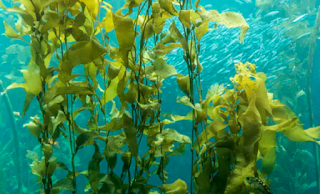
A kelp forest
Photograph
courtesy of The Conversation.com
Kombu Breton or Laminaire Digitée –(
traditionally known as Fouet des Sorcières)_ -Sea Tangle. (Latin - Laminaria
digitata).
Kombu Royal -
Sugar kelp, Sea Belt. (Japanese - karafuto-kombu), (Latin - saccharina
latissimi).
Kombu Algue Brune - (Japanese - mitsuishi-kombu, dashi-kombu, mizu-kombu, hidaka kombu), (Latin - laminaria angustata),.

Kelp
Photograph
courtesy of star5112
www.flickr.com/photos/johnjoh/283891405/
Laitue de Mer - Lettuce of the sea. Laitue de Mer – Sea lettuce. While this seaweed can be eaten fresh or cooked it is mostly seen in seaweed salads. (Latin - ulva lactuca).

Organic
sea lettuce
Photograph courtesy of Algae World News
Porphyre – Pyropia, Laver, Nori in Japanese, and the seaweed traditionally used to wrap sushi and onigiri and now grown in France. In the UK this is the most well-known edible seaweed under the name laver. To my surprise this seaweed doesn’t only come in green, there are red and purple varieties as well. Laver seaweed is a traditional Welsh dish called bara lawr, laverbread. With added oatmeal, laverbread is often eaten with bacon and cockles for a real Welsh breakfast.

Seabass
with Greens and Laverbread Sauce
Photograph
courtesy of Gourmet Wales.
Laver is also used in soups and sauces for lamb, crab, monkfish and other seafood products. Other parts of Britain and Ireland also have traditional dishes made with laver. (Latin - pyropia yezoensis and pyropia tenera).
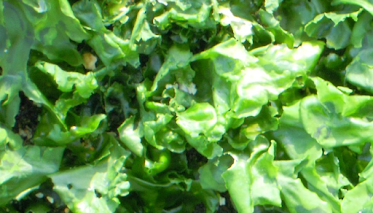
Laver - Nori
Photograph courtesy of Monterey Bay Seaweeds
Spaghetti de Mer, Haricot de Mer - Sea spaghetti, thong weed, sea thong that resembles green tagliatelle. Once harvested, sea spaghetti is dried, at low temperatures to lock in the vitamins. Sea Spaghetti cooks like pasta and keeps an al dente bite and a firm bite like well-prepared tagliatelle. (Latin - Hhimanthalia elongate).
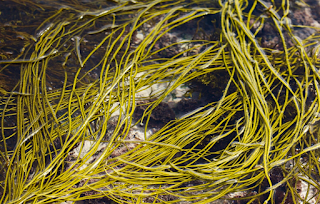
Spaghetti de
Mer - Sea Spaghetti.
Photograph courtesy of Provenance.org and Atlantic Kitchen
Salicorne, Perce-pierre, Criste-marine– Salicornia or samphire is not a seaweed, but since it grows in rocky areas very close to the sea, it is often used like a seaweed. Young salicornia plants are gathered from April through July and then will be used in salads, sauces, soups; they may also be pickled and then used as a condiment. Their shape gives them another name, the asparagus of the sea; however, that refers to their look, not their taste. (Latin - salicornia europaea).
Varech, Lessonie Brunâtre – Kelp, Brown Rib-Weed, Babberlocks - Kelp grows in underwater forests. Two hundred years ago kelp was already an important crop as it could be burned to obtain soda ash used to manufacture of glass, detergents and soaps, chemicals and other industrial products. Today, kelp is mostly seen in the food industry as soda ash mostly comes from other sources. (The ancient Egyptians, 5,000 years ago, used soda ash from kelp for glass manufacture and the Romans used it in baking bread. Baking Soda comes from soda ash). (Latin - alaria esculenta).
North European Kelp - Laminaria hyperborean
More about the seaweeds on French menus.
French menus with seaweed in their listings only rarely indicate a specific seaweed. It appears that two or more seaweeds are often used in combination and listing them all would take away from the main part of the dish. Seaweed is a real sea vegetable and has calcium, magnesium, and iron, iodine, zinc along with vitamins A and C.
Learning about seaweed in foods and cosmetics.
If you're in Brittany, France, near Roscoff, famous both for its AOP onions and its important ferry terminal and port it is also home to a commercial center for the investigation, discovery and research into seaweed. Thalado – Centre de Découverte des Algues, Rue Victor Hugo, 29680, Roscoff Cedex; https://www.thalado.fr/en/-pxl-62.html. At the center you can learn about cooking with seaweed, with lectures, slideshows, videos and cooking demonstrations. The center has a retail outlet and online sales for many types of products made with seaweed.
--------------------------------









